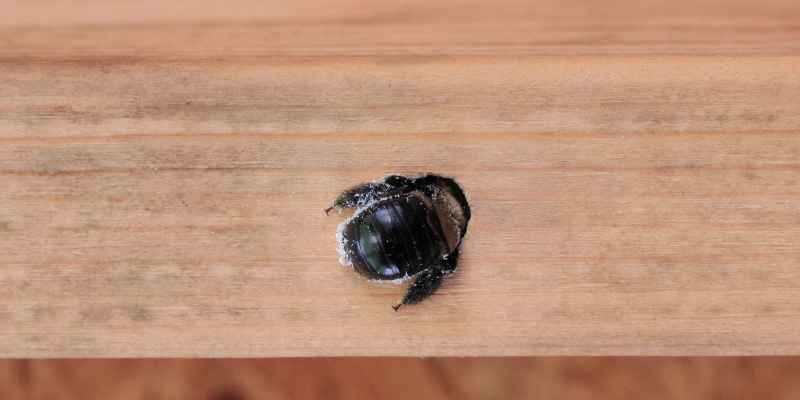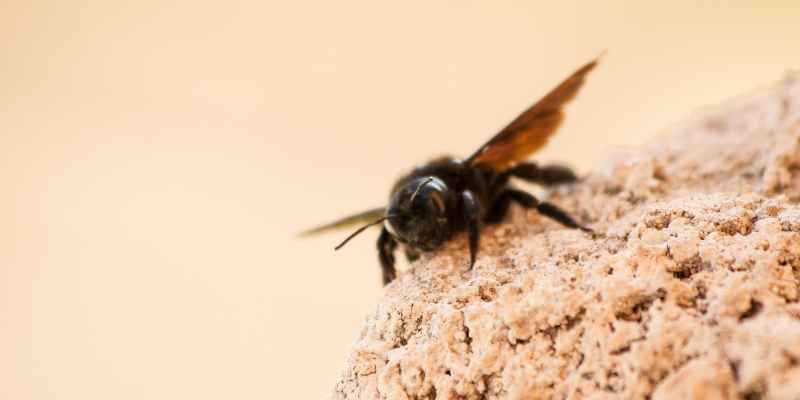Protect wood from carpenter bees by using insecticidal dust applied directly into the holes using a hand duster. For longer-term infestations, the dust prevents the larvae from reproducing, making it an ideal solution.
Natural repellents made from citrus fruits also prevent carpenter bees from nesting in existing holes. Painting or staining wood can also deter carpenter bees from nesting on your property. This article will discuss other effective ways to protect wood from carpenter bees.
Carpenter bees are notorious for damaging and destroying wood structures. These bees dig holes into wood to lay their eggs and can cause major structural damage if left unaddressed. Homeowners often struggle with finding effective methods to protect their wood structures from these pests. We will explore various ways to protect wood from carpenter bees, including prevention techniques, DIY solutions, and professional treatments. By following these tips, you can keep carpenter bees from ruining your wood structures and property.
Understanding Carpenter Bees
Protecting wood from carpenter bees is important to prevent damage to your property. Applying insecticidal dust directly into the holes and using natural repellents made from citrus fruits can discourage these bees from making nests in your wood. Alternatively, traps and blockers can also help manage and control carpenter bee infestations.
Carpenter bees can be a nuisance to homeowners who have wooden structures in their yards. It is essential to understand the behavior of these bees to know how to protect wood from them. Carpenter bees get their name from their ability to create tunnels in wood to build their nests. They are about an inch in length and have a shiny black abdomen. Male carpenter bees are curious and may fly close to humans, but they cannot sting. Female carpenter bees can sting, but they rarely do so unless provoked. Understanding carpenter bees’ behavior is crucial in protecting your wooden structures from damage.
Damage Caused By Carpenter Bees
Carpenter bees can cause severe damage to wooden structures. They create perfectly round holes in wood that are about the size of a dime. Female carpenter bees enter these tunnels to lay their eggs, and the larvae feed on the wood. Over time, these tunnels can weaken the wood structure, leading to costly repairs. If left untreated, the damage can be extensive and pose a safety hazard.
Behavior Of Carpenter Bees
Carpenter bees prefer to nest in untreated wood, such as fascia boards, decks, or pergolas. They are attracted to the smell and texture of bare wood, making these structures a prime target. It is essential to seal any exposed wood surfaces to prevent carpenter bees from nesting. Carpenter bees are most active in the spring and summer months when they mate and build their nests. It is during this time that they cause the most damage to wooden structures.
To summarize, understanding the behavior of carpenter bees is crucial in protecting wooden structures from damage. Carpenter bees cause severe damage by creating perfectly round holes in wood, and they prefer to nest in untreated wood. To prevent carpenter bee damage, it is important to seal any exposed wood surfaces and apply insecticidal dust more deeply into the wood for longer-term infestations.

How To Identify Carpenter Bees
Carpenter bees can cause damage to wood, but identifying them can be tricky as they look similar to bumblebees. Look for large, solitary bees with shiny black abdomens and yellow/orange hairs on their thorax. To protect your wood, you can use insecticidal dust, natural repellents made from citrus fruits, or carpenter bee traps.
Carpenter bees are large, stout-bodied bees that closely resemble bumblebees. However, there are some physical characteristics that distinguish them from other types of bees. Identifying carpenter bees can help you take preventive measures to protect your wood from infestation.
Physical Characteristics of Carpenter Bees:
Here are some unique physical characteristics to help you identify carpenter bees:
– Size: Carpenter bees are about one inch in length, making them one of the largest bees in North America.
– Coloration: Carpenter bees are usually black, but some species have yellow or green markings on their bodies. They also have a shiny and smooth appearance.
– Body shape: Carpenter bees have a stout and robust body. They have an identifiable large, round head that is noticeably distinct from their body.
– Wingspan: Carpenter bees have a wingspan of about an inch.
– Abdomen: Carpenter bees have a shiny, hairless abdomen that is cylindrical in shape and looks like a dark-colored pencil.
Difference between Carpenter Bees and Bumblebees:
Carpenter bees closely resemble bumblebees in size and color. So, it is important to differentiate between the two to determine whether you have a carpenter bee infestation. Here are some differences that can help you tell them apart:
– Carpenter bees have a larger and more robust body as compared to bumblebees.
– Carpenter bees have a hairless, shiny, and dark-colored abdomen that is cylindrical in shape. In contrast, bumblebees have a fuzzy, round abdomen that is light-colored and striped.
– Carpenter bees have a more noticeable head as compared to bumblebees, which appears to blend with their body.
– Carpenter bees are solitary bees, while bumblebees are social bees.
By identifying carpenter bees and distinguishing them from other bees, you can take measures to protect your wood from infestation. With some simple steps, you can keep your wood safe from carpenter bees.
Prevention Of Carpenter Bees
Protecting wood from carpenter bees can be achieved through several methods such as insecticidal dust, natural repellents with citrus, and traps. Applying the dust deeply into the wood can prevent larvae reproduction, while citrus fruit peels boiled in water can ward off carpenter bees.
Regularly checking and painting the wooden surfaces can also deter them away.
Carpenter bees are notorious wood destroyers, and if left unchecked, they can cause severe damage to your wooden structures. However, you can prevent them from taking over your property by implementing some simple yet effective measures. Here are some useful tips on how to prevent carpenter bees from damaging your wood.
Painting And Staining Wood
One of the primary ways to protect your wood from carpenter bees is to paint or stain it. By doing so, you create a protective barrier that makes it harder for these bees to bore into the wood. Moreover, paint and stain can cover the cracks and holes on the wood surface, which are usually the places where carpenter bees start their tunneling. So, make sure to apply high-quality paint or stain to your wooden structures and maintain them regularly.
Use Of Repellents
Another option for preventing carpenter bees is to use repellents. These are substances that contain natural or synthetic chemicals that repel carpenter bees. Some examples include citrus oil, cinnamon, and cedar oil. You can apply these repellents to the surface of the wood, and they will keep the carpenter bees at bay. However, be cautious when using these substances, as some of them may be toxic to humans or pets.
Covering The Holes And Cracks
As mentioned earlier, carpenter bees usually start their tunneling at the cracks and holes on the wood surface. Hence, covering these openings can prevent the bees from entering. You can use caulk, wood filler, or putty to fill in the gaps. Make sure to seal all the crevices and gaps to make it harder for the bees to initiate their boring.
Replacing Damaged Wood
If you notice any severely damaged wood, the best course of action is to replace it. Carpenter bees are more attracted to untreated, moist, and decaying wood, so by removing and replacing it with new treated wood, you eliminate the primary nesting site for these bees.
Covering The Wood With Metal Flashing
Finally, you can cover the wood with metal flashing. This is an effective way to prevent carpenter bees from boring into the wood. The metal flashing acts as a physical barrier that the bees cannot penetrate. This method is especially useful if you have a wooden structure in an area that is highly susceptible to carpenter bee infestation.
In conclusion, preventing carpenter bees from damaging your wood requires a combination of strategies. By painting or staining the wood, using repellents, covering the holes and cracks, replacing damaged wood, and covering the wood with metal flashing, you can effectively protect your wood from these destructive insects.

Treating The Carpenter Bee Infestation
Protecting your wood from carpenter bees is crucial to prevent infestations. Using insecticidal dust applied deeply into the wood with a hand duster is an effective way to treat the holes and prevent larvae reproduction. Natural repellents made from citrus fruits can also ward off carpenter bees.
infestations can cause serious damage to your wooden structures. It’s important to treat the infestation before it causes any irreparable damage to your property. Here are a few methods you can use to treat carpenter bee infestations.
Application Of Insecticidal Dust
Applying insecticidal dust is an effective way of treating carpenter bee infestations. The dust is applied directly into the holes made by the bees. It’s ideal for longer-term infestations and prevents the larvae from reproducing. You can use a hand duster to apply the insecticidal dust into the hole.
Installing Carpenter Bee Traps
Carpenter bee traps are another effective way of treating infestations. The traps lure the bees using light and sweet smells and catch them in a container. You can install the traps around your wooden structures to prevent the bees from damaging the wood. Be sure to check and empty the traps regularly.
Using Pesticides
Pesticides can also be used to treat carpenter bee infestations. However, they should be used with caution as some pesticides can be harmful to humans and pets. If you choose to use pesticides, be sure to read and follow the manufacturer’s instructions carefully. Wear protective clothing and follow safety precautions.
Protecting your wooden structures from carpenter bees is important to prevent costly repairs and maintenance. Use these methods to treat carpenter bee infestations and keep your property safe.
DIY Carpenter Bee Control
Protecting your wood from carpenter bees is crucial. DIY carpenter bee control can be done by using insecticidal dust to prevent the larvae from reproducing or using natural repellents made from citrus fruits to ward off the bees. You can also use carpenter bee traps or blocker kits to avoid further damage.
Carpenter bees are a common problem for those who have a wooden structure in their homes or gardens. They can cause extensive damage to wood over time, so it’s important to take control measures to reduce the risk of infestation and damage. DIY Carpenter Bee Control can be done in several ways to prevent and treat carpenter bee infestations in your property.
Application of Insecticidal Dust
Insecticidal dust is a great way to get rid of carpenter bees. It can be applied more deeply into the wood and is ideal for longer-term infestations. Additionally, it prevents the larvae from reproducing, which helps to control the population of carpenter bees in your property. Make sure to use a hand duster to spray the dust directly into the hole.
Installation of Carpenter Bee Traps
Installing carpenter bee traps is a traditional and non-toxic approach to control the carpenter bee population. The trap is designed to simulate the nest using untreated wood, which attracts carpenter bees. The carpenter bees then enter and get trapped inside the trap. Once trapped, release them into nearby woods. This method is effective when the infestation of carpenter bees is low.
Use of Natural Repellents
Natural repellents, such as Bees Oil by GOLDENTEAK, can help repel carpenter bees from wooden structures. Cedarwood, tea tree oil, and peppermint oil are also natural insect repellents that can be sprayed onto the wood to deter carpenter bees.
In Summary
DIY Carpenter Bee Control is a great way to protect your home or garden from carpenter bees. By applying insecticidal dust, installing carpenter bee traps, or using natural repellents, you can control the carpenter bee population and reduce damage to your wooden structure. Remember to use these methods at the start of carpenter bee activity to control infestation.
Professional Carpenter Bee Control
Professional carpenter bee control is essential to protect wood from these destructive insects. Various products such as insecticidal dust, outdoor traps, and carpenter bee blockers are available in the market that can prevent carpenter bees from making their nests in existing holes and damaging the wood.
Regular inspections and preventive measures can help keep your wooden structures secure from carpenter bees.
When To Call A Professional
Carpenter bees can be a nuisance, and their infestation in your wooden property can lead to severe damage. While DIY carpenter bee control methods can be effective, you may need to call a professional when the infestation is out of hand or when the wooden structure is too delicate to handle. A professional carpenter bee control service will have the experience and knowledge of dealing with carpenter bees and can use stronger chemicals to eliminate them. They also have the right tools and techniques to ensure that the infestation is eliminated correctly.
Tools And Techniques Used By Professionals
Professional carpenter bee control services have a range of tools and techniques they use to eliminate carpenter bees. They often use insecticides that target the larvae and adult bees, ensuring the infestation is dealt with properly. They also use dust insecticides that can be more deeply applied into the wood, preventing larvae from reproducing. This method is ideal for long-term infestations and helps prevent future damages. In addition, they use traps to catch adult bees and prevent further mating. Professionals also seal holes or cracks in wooden structures to prevent any further infestation.
In conclusion, professional carpenter bee control can help you protect your wooden property from carpenter bee infestation. If you’re experiencing difficulties dealing with the issue, they can also assist in proper identification and a customized treatment plan. If you’re in doubt about whether or not to call in a professional, consider factors such as the level of infestation, the type of wooden structure, and the ability to handle potent insecticides. Taking the necessary precautions to deal with carpenter bees can prevent severe damage in the long run.
Frequently Asked Questions For How To Protect Wood From Carpenter Bees
What Can I Put On Wood To Keep Carpenter Bees Away?
To keep carpenter bees away, use insecticidal dust that can be applied deeply into the wood to prevent the larvae from reproducing. You can also use natural citrus-based repellents by boiling lemon, lime, or orange peels in water. Painting or staining the wood with a sealing primer and exterior paint can also deter them from nesting.
What Do Carpenter Bees Hate The Most?
Carpenter bees dislike citrus, so natural repellents made from citrus fruits can ward them off. Applying insecticidal dust directly into the hole can prevent them from reproducing, but staining or painting all wood is an effective way to deter them from nesting on your property.
Will Painting Wood Prevent Carpenter Bees From Attacking It?
Yes, painting wood can prevent carpenter bees from attacking it. Painting all wood is an easy way to deter carpenter bees from nesting. Staining wood can also help, but paint is more effective. Use both a sealing primer and at least two coats of exterior paint when painting to prevent carpenter bees from attacking the wood.
What Coating Repels Carpenter Bees?
Using insecticidal dust can effectively repel carpenter bees from wood and prevent them from reproducing. Apply the dust directly into the hole in the wood using a hand duster. Citrus is also a natural repellent, so lemon, lime, or orange peels boiled in water can be used as a DIY repellent.
Painting or staining the wood can also deter carpenter bees from nesting.
Conclusion
Carpenter bees can cause major damage if left unchecked. However, there are several ways to protect your wood from these pests. Using insecticidal dust and natural repellents can save you from big problems in the long run. Regularly painting and staining your wooden structures can also serve as a deterrent.
By following these simple steps, you can ensure that your property remains free from the damage caused by carpenter bees.


